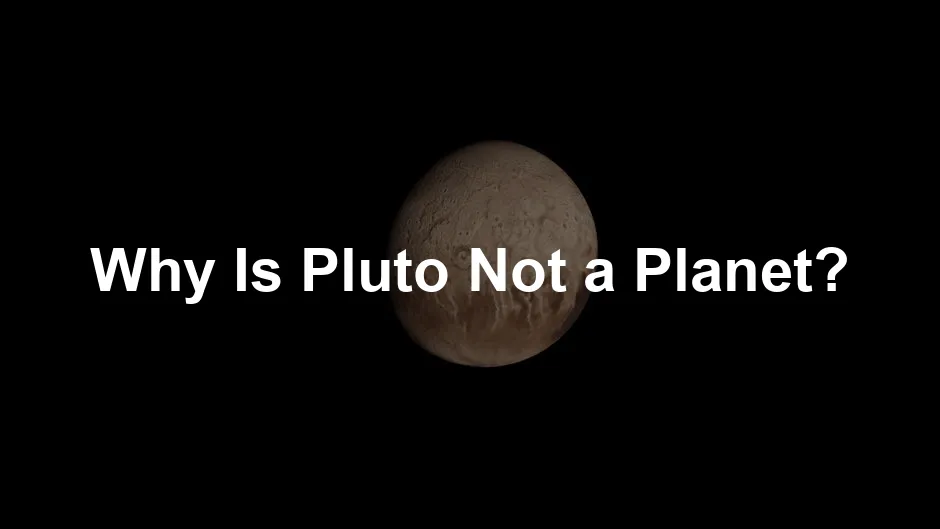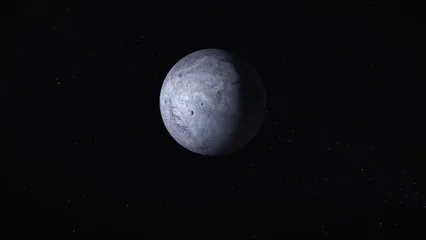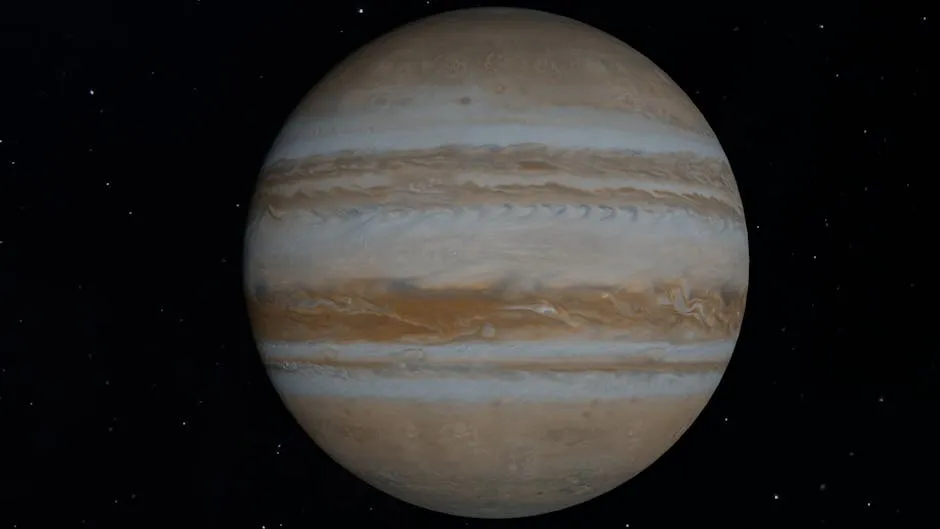
Why Is Pluto Not a Planet?
Introduction
Pluto was once celebrated as the ninth planet in our solar system. Its reclassification by the International Astronomical Union (IAU) in 2006 marked a significant shift in astronomy. But why did this happen? What criteria influenced such a pivotal decision?
If you’re curious about the history of Pluto and want to dive deeper, consider picking up “Pluto: A History of the Former Ninth Planet” by Chris Ferrie. This engaging read will give you insights into why Pluto has captured our imaginations for so long.
Summary and Overview
Discovered in 1930 by Clyde Tombaugh, Pluto was initially hailed as the ninth planet. For decades, it held this title, captivating the public and scientists alike. However, as astronomers discovered more about our solar system, especially the Kuiper Belt, our understanding of what constitutes a planet evolved.

In 2006, the IAU established a formal definition for planets. A celestial body must meet three criteria: it must orbit the Sun, be massive enough for a nearly round shape, and clear its orbit of other debris. Pluto, while satisfying the first two criteria, fails on the last one. It shares its orbital space with other objects of similar size, such as those found in the Kuiper Belt. This led to a heated debate among astronomers and the public about its status, with many still advocating for Pluto’s planetary classification.
The discussion surrounding Pluto’s classification raises important questions about what defines a planet. why is pluto not a planet
The Discovery of Pluto
Historical Context
In the early 20th century, astronomers were intrigued by anomalies in the orbits of known planets, particularly Uranus. Percival Lowell, founder of the Lowell Observatory, initiated a search for a hypothetical “Planet X,” believing it influenced Uranus’s orbit. After many years, Clyde Tombaugh took over this quest.
Using a method of comparing photographic plates, Tombaugh discovered Pluto on February 18, 1930. This marked a thrilling moment in astronomy. Pluto was named shortly after, inspired by an 11-year-old girl named Venetia Burney, who suggested the name of the Roman god of the underworld.
Pluto’s discovery represented the culmination of decades of astronomical investigation, but its journey from planet to dwarf planet had yet to unfold.

Naming Pluto
When Pluto was discovered in 1930, its name was inspired by mythology. An 11-year-old girl named Venetia Burney suggested it. She believed the name of the Roman god of the underworld was fitting. Venetia’s grandfather, a notable figure in the astronomical community, shared her suggestion with the Lowell Observatory. The name was officially adopted shortly after the announcement of Pluto’s discovery. This charming story highlights how even the smallest voices can leave a lasting mark on science.
For those looking to explore more about the solar system, I highly recommend “The Solar System: A Visual Exploration” by National Geographic. It’s a stunning visual journey that brings our cosmic neighborhood to life!
The Reclassification of Pluto
IAU Definition of a Planet
In 2006, the International Astronomical Union (IAU) introduced a clear definition for what constitutes a planet. According to the IAU, a celestial body must meet three criteria:
- It must orbit the Sun.
- It must possess enough mass to form a nearly round shape.
- It must have cleared its orbital neighborhood of debris.
These criteria aimed to differentiate planets from smaller celestial bodies, such as asteroids and comets.

Pluto’s Characteristics
Pluto meets the first two criteria. It orbits the Sun and is massive enough to maintain a nearly round shape. However, it fails to meet the third criterion. Pluto shares its orbital region with other objects of similar size, including several known as plutinos. These bodies reside in the Kuiper Belt, a region beyond Neptune filled with icy remnants from the solar system’s formation.
Pluto’s inability to clear its orbit of other debris led to its reclassification as a dwarf planet. This decision sparked discussions among scientists and the public about the nature of planetary classification.
If you’re intrigued by the complexities of planetary science, check out “The Kuiper Belt: A Study of the Outer Solar System” by Karen C. Fox. It provides a fascinating look into this distant region and its significance in our solar system.

The Kuiper Belt and Similar Objects
What is the Kuiper Belt?
The Kuiper Belt is a vast region of space beyond Neptune, home to thousands of icy bodies. Its significance lies in its role as a reservoir of ancient solar system materials. The belt contains many objects similar to Pluto, including dwarf planets like Haumea and Makemake. These celestial bodies share traits with Pluto, reinforcing its classification as part of this intriguing region.
Understanding the Kuiper Belt enhances our knowledge of planetary formation and evolution. As we study these distant objects, we gain insight into the processes that shaped our solar system billions of years ago. Want to get a hands-on experience? Consider the Solar System Model Kit – Educational Science Toy. It’s a fun way to learn about our cosmic neighborhood!

The New Horizons Mission
Overview of the Mission
In 2006, NASA launched the New Horizons spacecraft. Its mission? To fly by Pluto and gather vital data. Traveling for nearly a decade, it reached Pluto on July 14, 2015. This historic encounter marked the first close-up look at Pluto. Scientists eagerly anticipated what this mission would reveal.
New Horizons aimed to study Pluto’s geology, atmosphere, and moons. It carried a suite of scientific instruments designed to capture high-resolution images and analyze surface composition. As it approached, excitement built among astronomers and space enthusiasts alike.

For those interested in space exploration, “New Horizons: The Story of NASA’s Mission to Pluto” by Jason Davis is a must-read. It beautifully captures the mission’s challenges and triumphs. Check it out here.
Key Discoveries
The flyby transformed our understanding of Pluto. New Horizons revealed a diverse landscape, showcasing mountains, valleys, and ice plains. One of its most striking features is Sputnik Planitia, a vast nitrogen ice plain. This region exhibits signs of geological activity, suggesting that Pluto is far from a static world.

Pluto’s atmosphere also surprised scientists. The spacecraft detected a thin atmosphere composed mainly of nitrogen, with traces of methane and carbon monoxide. This discovery challenged previous assumptions about Pluto’s climate and potential for geological processes.
These findings ignited public interest in Pluto. Many people who had grown up thinking of it as the ninth planet were fascinated by its complexity. The mission not only provided new data but also sparked discussions about what defines a planet and the nature of our solar system. As a result, Pluto remains a captivating subject of study and debate.
Public Sentiment and Ongoing Debate
Arguments for Pluto as a Planet
Despite its reclassification, many still argue passionately for Pluto’s status as a planet. One key argument focuses on historical context. Pluto was classified as the ninth planet upon its discovery in 1930. For generations, it held that title, leading many to feel a sentimental attachment to it.
Some astronomers highlight inconsistencies in the IAU’s criteria. They argue that other planets, like Earth and Jupiter, also share their orbits with numerous other objects, yet still retain their planetary status. This raises questions about the fairness of the IAU’s definitions.
Others advocate for a broader definition of a planet. They suggest that any celestial body with sufficient mass and a stable orbit should qualify. Under this definition, Pluto, with its unique characteristics and significant size relative to other dwarf planets, would undoubtedly fit the criteria.

On the topic of planetary exploration, consider checking out “Astrophysics for People in a Hurry” by Neil deGrasse Tyson. This book offers a quick and witty overview of the universe, perfect for curious minds!
Criticisms of IAU’s Definition
The International Astronomical Union (IAU) defined a planet using three strict criteria. Critics argue that these criteria might not reflect the complexity of celestial bodies. For instance, many feel that the requirement to “clear its orbit” is too restrictive. They point out that Earth and Jupiter also share their orbits with numerous asteroids yet remain classified as planets.
Some scientists advocate for a broader definition of a planet, one that focuses on mass and shape rather than orbital dominance. Under this alternative view, any sizable, round object orbiting the Sun could qualify. This perspective emphasizes the diverse range of celestial bodies and their unique characteristics.
Moreover, the discovery of other similar objects in the Kuiper Belt, like Eris and Haumea, raises questions about how we categorize these distant worlds. Many believe this calls for a reevaluation of the definitions set forth by the IAU. The debate continues, as many still feel a strong emotional connection to Pluto’s status as a planet.

Conclusion
In summary, Pluto’s reclassification from planet to dwarf planet has sparked significant debate. The IAU’s criteria have faced criticism for being too rigid. Despite its new status, Pluto remains vital to our understanding of the solar system. Its unique features and the ongoing exploration could change its classification in the future. As we discover more about our cosmic neighborhood, who knows what surprises await us?
If you want to delve deeper into the cosmos, consider reading “The Universe in a Nutshell” by Stephen Hawking. It’s a brilliant exploration of the cosmos that is both informative and entertaining!
FAQs
Why was Pluto demoted from planet status?
Pluto was reclassified as a dwarf planet by the IAU in 2006. This decision was based on three criteria for planet classification. While Pluto orbits the Sun and is nearly round, it has not cleared its neighboring region of other objects. This means it shares its orbital path with several similar bodies, particularly in the Kuiper Belt.
What is a dwarf planet?
A dwarf planet is a celestial body that orbits the Sun and is massive enough to be rounded by its own gravity. However, it has not cleared its orbital neighborhood of other debris. Pluto fits this definition, along with other bodies like Ceres and Eris.
Does Pluto have any moons?
Yes, Pluto has five known moons. The largest is Charon, which is nearly half the size of Pluto itself. Charon and Pluto are often considered a binary system due to their size difference. The other moons are Nix, Hydra, Kerberos, and Styx, all of which are smaller and irregularly shaped.
What are the main characteristics of Pluto?
Pluto is a rocky and icy body located in the Kuiper Belt, with a diameter of about 1,477 miles. It orbits the Sun at an average distance of about 3.7 billion miles. Its surface features include mountains, valleys, and plains, along with a thin atmosphere of nitrogen, methane, and carbon monoxide.
Could Pluto ever regain its planet status?
The ongoing debate about Pluto’s classification remains lively. Some scientists advocate revisiting the definitions set by the IAU. As new discoveries emerge and our understanding of the solar system evolves, there is potential for Pluto’s status to change once again.
Please let us know what you think about our content by leaving a comment down below!
Thank you for reading till here 🙂
All images from Pexels




